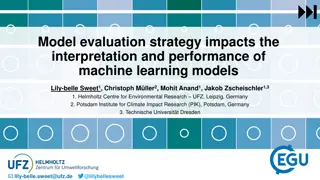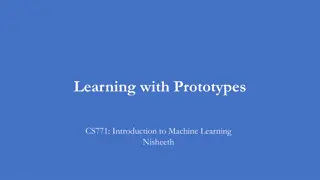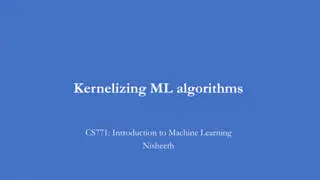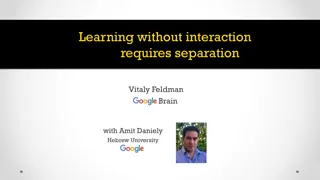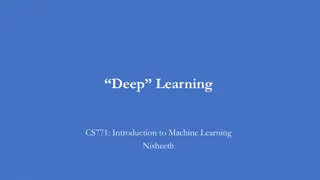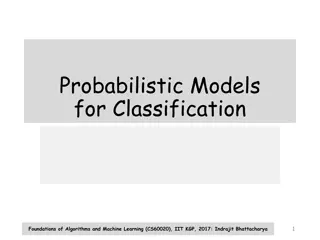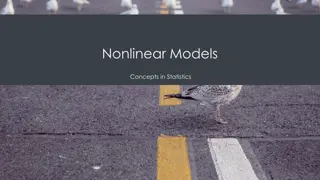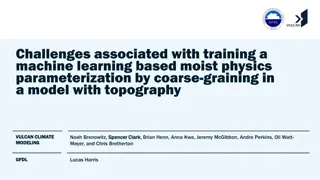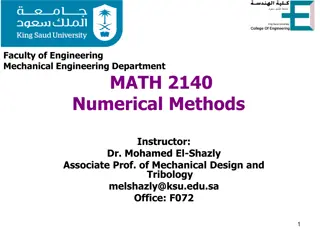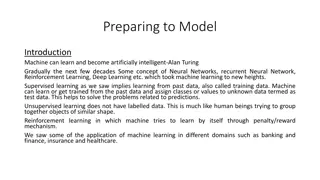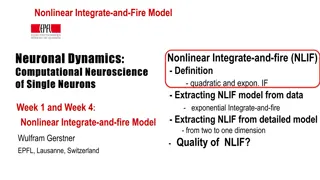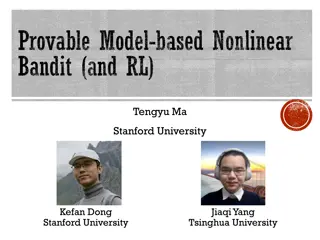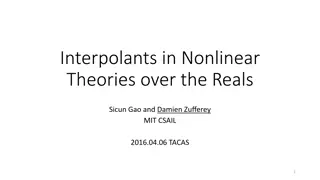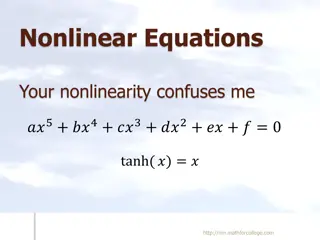Understanding the Power of Nonlinear Models in Machine Learning
Delve into the limitations of linear models for handling nonlinear patterns in machine learning. Explore how nonlinear problems can be effectively addressed by mapping inputs to higher-dimensional spaces, enabling linear models to make accurate predictions. Discover the significance of feature mapping and the implications of nonlinear mappings in learning complex patterns.
Download Presentation

Please find below an Image/Link to download the presentation.
The content on the website is provided AS IS for your information and personal use only. It may not be sold, licensed, or shared on other websites without obtaining consent from the author. Download presentation by click this link. If you encounter any issues during the download, it is possible that the publisher has removed the file from their server.
E N D
Presentation Transcript
The Kernel Trick CS771: Introduction to Machine Learning Nisheeth
Logistics By now, all of you should have your mid sem results Anyone who doesn t have them should email their TA, cc-ing me Assignment 3 will be released after Wednesday s class Will be due next weekend (you will have 10 days) Quiz 3 will be this Friday Syllabus is everything we covered until the last class Your TA will share complete course marks for all assessments in the course so far later this week Please cross-check your marks and submit regrading requests if you find any discrepancies CS771: Intro to ML
3 Limits of linear Models Nice and interpretable but can t learn nonlinear patterns So, are linear models useless for such problems? CS771: Intro to ML
4 Linear Models for Nonlinear Problems Consider the following one-dimensional inputs from two classes ? Can t separate using a linear hyperplane CS771: Intro to ML
5 Linear Models for Nonlinear Problems Consider mapping each ? to two-dimensions as ? ? = ?1,?2 = [?,?2] Linear hyperplane Classes are now linearly separable in the two-dimensional space CS771: Intro to ML
6 Linear Models for Nonlinear Problems The same idea can be applied for nonlinear regression as well ? ? = ?1,?2 = [?,cos(?)] Not a linear relationship between inputs (?) and outputs (?) A linear regression model will work well with this new two-dim representation of the original one-dim inputs A linear regression model will not work well CS771: Intro to ML
7 Linear Models for Nonlinear Problems Can assume a feature mapping ?that maps/transforms the inputs to a nice space The linear model in the new feature space corresponds to a nonlinear model in the original feature space .. and then happily apply a linear model in the new space! CS771: Intro to ML
8 Not Every Mapping is Helpful Not every higher-dim mapping helps in learning nonlinear patterns Must be a nonlinear mapping For the nonlinear classification problem we saw earlier, consider some possible mappings CS771: Intro to ML
9 How to get these good (nonlinear) mappings? Can try to learn the mapping from the data itself (e.g., using deep learning - later) Can use pre-defined good mappings (e.g., defined by kernel functions - today s topic) Thankfully, using kernels, you don t need to compute these mappings explicitly Even if I knew a good mapping, it seems I need to apply it for every input. Won t this be computationally expensive? The kernel will define an implicit feature mapping Important: Important: The idea can be applied to any ML algo in which training and test stage only require computing pairwise similarities b/w inputs Also, the number of features will increase? Will it not slow down the learning algorithm? In a high-dim space implicitly defined by an underlying mapping ? associated this this kernel function ?(.,.) Kernel: A function ?(.,.) that gives dot product similarity b/w two inputs, say ?? and ?? ?(??, ??) = ?(??) ?(??) does not require computing the mapping ? Important: As we will see, computing ?(.,.) CS771: Intro to ML
10 Kernels as (Implicit) Feature Maps Consider two inputs (in the same two-dim feature space): ? = [?1,?2],? = [?1,?2] Suppose we have a function ?(.,.) which takes two inputs ? and ? and computes Called the kernel function This is not a dot/inner product similarity but similarity using a more general function of ? and ? (square of dot product) Can think of this as a notion of similarity b/w ? and ? ? ?,? = (? ?)2 = (?1?1+ ?2?2)2 explicitly. Just using the definition of the kernel ? ?,? = (? ?)2implicitly gave us this mapping for each input Didn t need to compute ? ? Remember that a kernel does two things: Maps the data implicitly into a new feature space (feature transformation) and computes pairwise similarity between any two inputs under the new feature representation 2?1 2+ ?2 2?2 2+ 2?1?2?1?2 = ?1 2 (?1 Thus kernel function ? ?,? = (? ?)2 implicitly defined a feature mapping ? such that for ? = [?1,?2] , ? ? = ?1 2, 2?1?2,?2 = ? ? ?(?) 2, 2?1?2,?2 2) = ?1 Dot product similarity in the new feature space defined by the mapping ? 2, 2?1?2,?2 2 Also didn t have to compute ? ? ?(?). Defn ? ?,? = (? ?)2gives that CS771: Intro to ML
11 As we saw, kernel function ? ?,? = (? ?)2 implicitly defines a feature mapping ? such that for a two-dim ? = [?1,?2] , ? ? = ?1 Kernel Functions 2, 2?1?2,?2 2 Every kernel function ? implicitly defines a feature mapping ? ? takes input ? ?(e.g., ?) and maps it to a new feature space The kernel function ? can be seen as taking two points as inputs and computing their inner-product based similarity in the space For some kernels, as we will see shortly, ? ? (and thus the new feature space ) can be very high-dimensional or even be infinite dimensional (but we don t need to compute it anyway, so it is not an issue) needs to be a vector space with a dot product defined on it (a.k.a. a Hilbert space) Is any function ? ?,? = ? ? ?(?) for some ? a kernel function? No. The function ? must satisfy Mercer s Condition CS771: Intro to ML
12 Kernel Functions For ?(.,.) to be a kernel function ? must define a dot product for some Hilbert Space Above is true if ? is symmetric and positive semi-definite (p.s.d.) function (though there are exceptions; there are also indefinite kernels) Loosely speaking a PSD function here means that if we evaluation this function for ? inputs (?2pairs) then the ? ? matrix will be PSD (also called a kernel matrix) ? ?,? = ?(?,?) For all square integrable functions ? (such functions satisfy ? ?2?? < ? ? ? ?,? ? ? ???? 0 The above condition is essentially known as Mercer s Condition Let ?1,?2be two kernel functions then the following are as well ? ?,? = ?1?,? + ?2?,? : simple sum ? ?,? = ??1?,? : scalar product ? ?,? = ?1?,? ?2?,? : direct product of two kernels Can easily verify that the Mercer s Condition holds Can also combine these rules and the resulting function will also be a kernel function CS771: Intro to ML
13 Some Pre-defined Kernel Functions Remember that kernels are a notion of similarity between pairs of inputs Several other kernels proposed for non-vector data, such as trees, strings, etc Linear kernel: ? ?,? = ? ? Kernels can have a pre-defined form or can be learned from data (a bit advanced for this course) Quadratic Kernel: ? ?,? = (? ?)2 or ? ?,? = (1 + ? ?)2 Polynomial Kernel (of degree ?): ? ?,? = (? ?)? or ? ?,? = (1 + ? ?)? Radial Basis Function (RBF) or Gaussian Kernel: ? ?,? = exp[ ? ? ?2] Controls how the distance between two inputs should be converted into a similarity Gaussian kernel gives a similarity score between 0 and 1 ? > 0 is a hyperparameter (called the kernel bandwidth parameter) The RBF kernel corresponds to an infinite dim. feature space (i.e., you can t actually write down or store the map ? ? explicitly but we don t need to do that anyway ) Also called stationary kernel : only depends on the distance between ? and ? (translating both by the same amount won t change the value of ?(?,?)) Kernel hyperparameters (e.g.,?,?) can be set via cross-validation CS771: Intro to ML
14 RBF Kernel = Infinite Dimensional Mapping We saw that the RBF/Gaussian kernel is defined as ? ?,? = exp[ ? ? ?2] Using this kernel corresponds to mapping data to infinite dimensional space ? ?,? = exp[ ? ?2] = exp( ?2)exp( ?2)exp(2??) (assuming ? = 1 and ? and ? to be scalars) 2????? ?! = exp( ?2)exp( ?2) ?=1 = ? ? ?(?) Thus an infinite-dim vector (ignoring the constants coming from the 2? and ?! terms Here? ? = [exp ?2?1,exp ?2?2,exp ?2?3, ,exp ?2? ] But again, note that we never need to compute ? ? to compute ? ?,? ? ?,? is easily computable from its definition itself (exp[ ? ?2] in this case) CS771: Intro to ML
15 Kernel Matrix Kernel based ML algos work with kernel matrices rather than feature vectors Given ? inputs, the kernel function ? can be used to construct a Kernel Matrix ? The kernel matrix ? is of size ? ? with each entry defined as Note again that we don t need to compute ? and this dot product explicitly ?(??) ???= ? ??,??= ? ?? ???: Similarity between the ?? and ?? inputs in the kernel induced feature space ? ? is a symmetric and positive semi-definite matrix Inputs ? ?? 0 ? ? Also, all eigenvalues of ? are non-negative Feature Matrix Kernel Matrix CS771: Intro to ML



